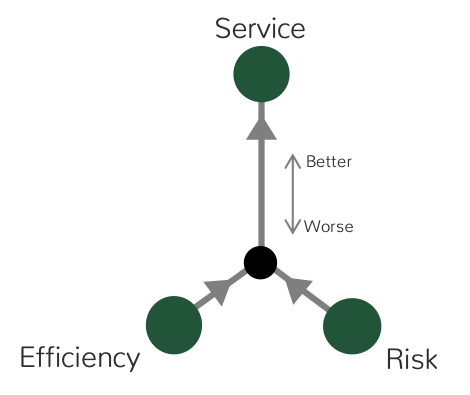The 3 Natural Forces of Service Operations

4 min read
Service operations are complex organisms that require careful coordination across many different stakeholders, geographies, technologies and other factors. The challenge for business leaders is to adequately consider and address these complex relationships while also balancing short term needs against long term business objectives.
This complex web of people, policy and technology revolves around three fundamental forces that naturally oppose one another. The three core forces of service operations are:
– Service: The quality of the operations output; often indirectly quantified by service level agreements, customer satisfaction or other measurements
– Efficiency: Relative amount of resources required to complete an operation; typically correlated with cost
– Risk: The potential for uncontrolled negative impacts on the operation

The 3 forces of service operations tend to have a reflexive negative impact on each other.
Natural Tendencies
Without any additional effort or intervention, efforts to improve one of these three areas tends to have a reflexive negative impact on the other two. Think of them like balls linked by a set of bungee cords—tugging on one outward will pull the others inward towards the center. It’s possible to resist this movement, but that requires additional force. It’s also possible to pull multiple balls outwards at the same time, but that requires even more force.
Long term business success requires all three forces to be adequately considered and managed. Failure to do so may drive some short-term gain but typically at the cost of longer term pain.
For example, consider efforts focused solely on improving service quality on a loan processing operation. Factors such as processing time could be greatly reduced by simply overstaffing the operation, but of course that would have a negative impact on efficiency. The amount of paperwork and complexity of processing steps could be reduced by eliminating compliance checks, but that would increase the risk of negative consequences from issuing bad loans. Improving service quality while maintaining, or even improving, efficiency and risk requires careful and nuanced actions driven by a complete end-to-end data-driven understanding on what is happening when, where and why within the operation.
At some level this framework may seem obvious, but we can all think of companies that have made mistakes on these forces—such as efforts focused on cost savings efforts (efficiency) that failed to adequately consider the remaining forces (service quality and risk).

Without additional effort, efforts to improve one of the three forces will tend to have a detrimental impact on the other two. For example, efforts to improve service will have a natural negative impact on efficiency and risk unless concerted efforts are made to counteract these effects.
For example, the mass movement of call centers to so called ‘low cost’ regions during the early 2000s quickly became a stereotype for bad management decisions. The basis of that blunder was fundamentally a failure to respect the 3 forces of service operations. Yes, just forklifting customer service operations offshore saved money—but doing so without careful data-driven execution quickly led to negative impacts on service quality and risk. The savings didn’t matter long term if annoyed customers took their business elsewhere. Many such firms eventually reversed course and brought their service operations back on-shore. Encountering such public-facing offshore customer support operations is now quite rare. With better management approaches these companies still found ways to still control costs but without ignoring the forces of service and risk.
Data and the 3 Forces
Used properly, data allows for operational leaders to see what is happening when, where and why within the operation. It’s quite hard to effectively manage something that you can’t measure or see.
The three forces of service operations provides a useful framework around which to build an end-to-end data collection and analytics plan. Measuring and analyzing efficiency without also monitoring service quality and risk (or any other combination that doesn’t include all three) is asking for trouble. Keen-eyed leaders should always be highly skeptical of efforts that cite data on achieving improvements in one of the three levers but remain silent on the others.
We can all relate to such uses of data to promote misleading improvements: “We’ve reduced costs 20% last quarter!” (…we’ll just gloss over the fact that our resulting poor service quality is now hurting our revenues) or “The new system significantly reduces compliance risks!” (…but unfortunately it’s so cumbersome that it takes twice as long to get anything done and so clunky that our customers just run to the competition).
Modern data-driven business leaders will increasingly demand their data to provide continual real-time insight into these three forces—with those insights presented in an actionable context that allows one to do something about a situation wondering off course.
Data should be used not only to monitor the impact of previous actions but also to plan and project the impact of future actions. For example, efficiency can be gained by more tightly planning the supply of skillsets against incoming demand—and solid data models should allow for both extensive testing of proposed staffing scenarios against historical volumes to assess the risk of such decisions. Real-time data analytics can and should also be used to quickly detect when a staffing model in wondering off course from, for example, an unexpected uptick in demand. Such a live data model could quickly identify a pool of under-utilized staff that could be quickly re-dispatched to meet demand elsewhere before more severe impacts to the operation materialize.
Respecting the 3 forces when managing, analyzing and reporting on complex service operations provides a strong foundation for balancing the needs of diverse stakeholders while also promoting long term sustaining business success.
Nicholas Hartman is the Chief Innovation Officer at CKM Analytix
